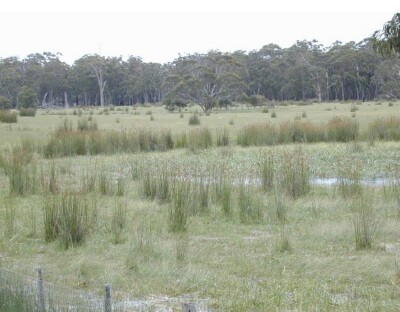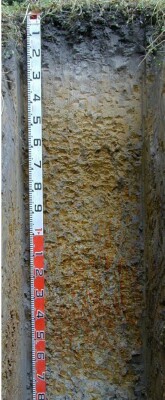DOW98 (Plot 3)
| Site: DOW98 (Plot 3) | Land Unit: Follet Dunes and Plains |
 |
The major landforms in this land unit are dunes and swales. Podosols and Kurosols or Chromosols are the major soil types found on the dunes and rises. Podosols are soils with a ‘coffee rock’ layer (refer to photograph below). The Kurosols or Chromosols tend to have a deep sandy topsoil over the clay. The common soil types on the swales are black cracking clay (Vertosols) or Grey Sodosols. Some Ferric Kurosols or Chromosols can also occur on the swales or lower slopes of the dunes. 2.5 year old Eucalyptus globulus plantation on ex-agricultural land |
Site Description:
| Geology: Quaternary aeolian | Landform pattern: Undulating Plain |
| Internal drainage: Imperfectly drained |
Soil Profile Morphology
| A1 | 0-12 cm | Very dark greyish brown (10YR3/2) sandy loam; single grain structure; very weak consistence when dry; many medium roots; clear and smooth transition to: |  |
| A2 | 12-20 cm | Yellow (10YR7/6) sand; single grain structure; loose consistence when dry; many medium ferruginous nodules; many medium roots; clear and smooth transition to: | |
| Subsoil | |||
| Bs | 20-25 cm | Yellow (10YR7/6) sand; single grain structure; loose consistence when dry; very many coarse ferruginous nodules; unable to assess macroporosity due to presence of many segregations; few very fine roots; sharp and smooth transition to: | |
| B21 | 25-75 cm | Brownish yellow (10YR6/8) with common medium faint yellowish red (5YR5/8) mottles, light clay; moderate polyhedral structure (20-50 mm) parting to moderate polyhedral structure (10-20 mm); firm consistence when moderately moist; common very fine macropores; areal porosity 0.05%; few very fine roots; diffuse and smooth transition to: | |
| B22 | 75-120 cm | Brown (10YR5/8) with many medium prominent light grey (10YR7/2) and red (2.5YR4/8) mottles, light medium clay; moderate polyhedral structure (20-50 mm) parting to strong polyhedral structure (10-20 mm); firm consistence when moderately moist; few very fine macropores; areal porosity 0.01%; few very fine roots; diffuse and smooth transition to: | |
| B3 | 120-170 cm | Light grey (10YR7/1) with common coarse prominent brownish yellow (10YR6/8) and red (2.5YR4/6) mottles, light medium clay; moderate polyhedral structure (20-50 mm) parting to moderate polyhedral structure (10-20 mm); firm consistence when moderately moist; few very fine macropores; areal porosity 0.01%; no roots observed. | |
| 170-400 cm | Grey heavy clays with pockets of red fine sandy clay, coarsely structured with slickensides, live roots observed to 300 cm, remnant roots observed to 400 cm. | ||
Notes: Sampled by: Ian Sargeant and Paul Feikema (11 December 2000)


